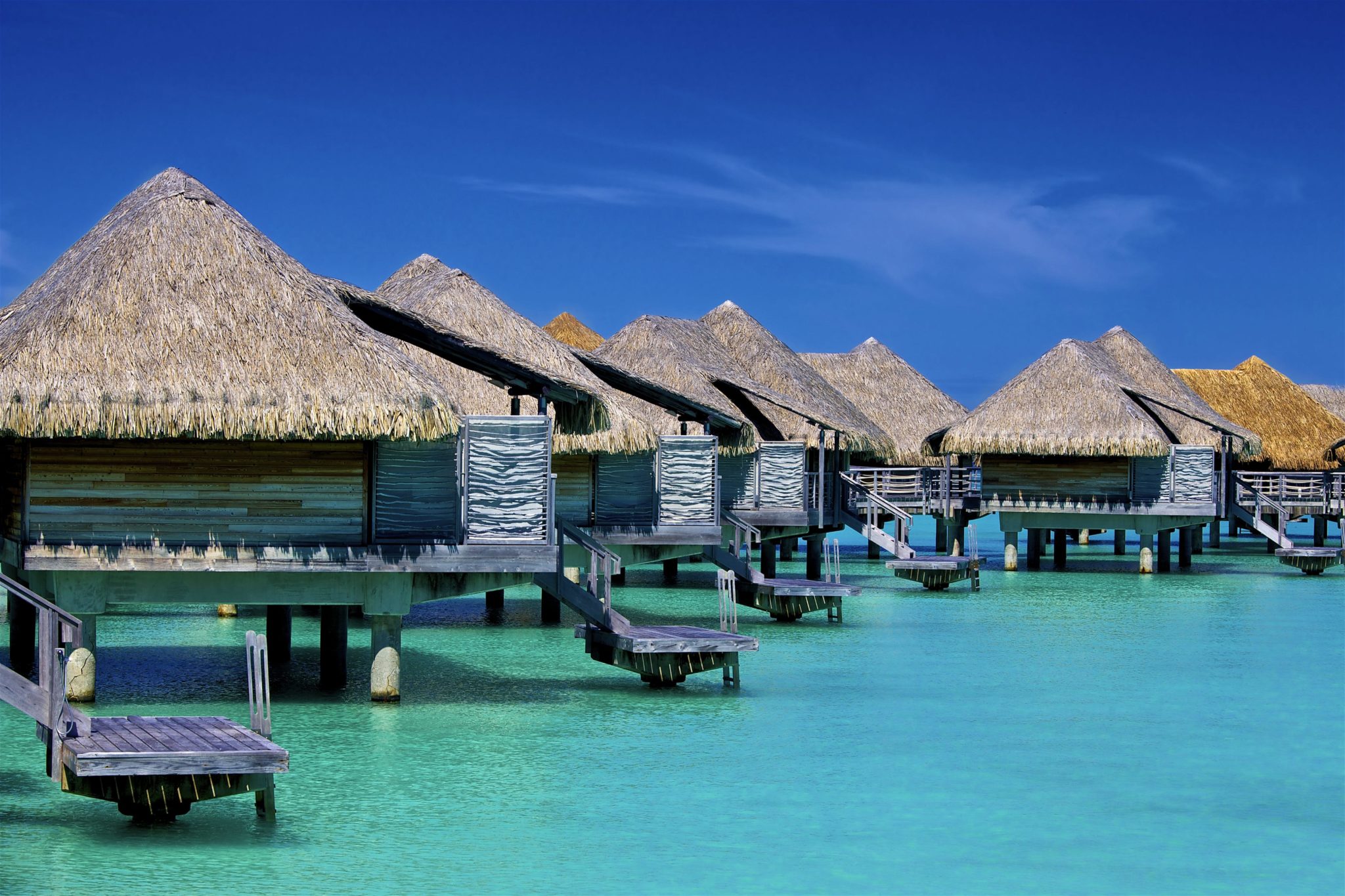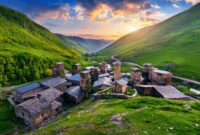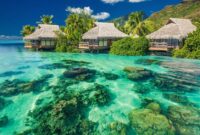Top vacation destinations in the world beckon travelers with diverse promises: sun-drenched beaches, majestic mountains, vibrant cultures, and thrilling adventures. This exploration delves into the criteria that define these coveted locales, examining factors ranging from natural beauty and cultural richness to infrastructure and safety. We’ll journey across continents, highlighting popular destinations and uncovering hidden gems, while also considering the impact of tourism and advocating for sustainable practices. Ultimately, this guide aims to inspire your next unforgettable escape.
From the bustling streets of iconic cities to the serene tranquility of secluded islands, the world offers a kaleidoscope of experiences. This journey will consider various travel styles, from adventurous treks to relaxing beach getaways, ensuring a diverse selection for every preference. We will investigate what makes a destination truly “top-tier,” analyzing the influence of social media, accessibility, and economic factors on a destination’s popularity. The discussion will also emphasize responsible tourism and the importance of preserving the unique character of each location.
Defining “Top” Vacation Destinations
Determining the world’s top vacation destinations is a complex endeavor, far from a simple matter of personal preference. While individual tastes undeniably play a significant role, a more objective approach requires considering a range of factors that contribute to a destination’s overall appeal and desirability. This involves a multifaceted assessment going beyond picturesque landscapes to encompass a broader spectrum of traveler needs and expectations.
The criteria used to define a “top” vacation destination are multifaceted and often subjective. However, several key elements consistently emerge in various rankings and travel guides. These elements contribute to a holistic evaluation of a destination’s desirability.
Criteria for Defining Top Vacation Destinations
Several factors contribute to a destination’s ranking as a “top” vacation spot. These criteria, while not exhaustive, provide a framework for a more comprehensive evaluation than relying solely on personal preferences. They encompass natural beauty, cultural experiences, practical considerations, and safety.
- Natural Beauty: This includes stunning landscapes, pristine beaches, unique geological formations, and abundant wildlife. The presence of iconic natural landmarks significantly enhances a destination’s appeal.
- Cultural Richness: A destination’s cultural heritage, including historical sites, museums, local traditions, cuisine, and art, significantly impacts its allure for tourists seeking enriching experiences. The preservation and accessibility of cultural assets are also crucial.
- Infrastructure and Amenities: Well-developed infrastructure, including efficient transportation systems, comfortable accommodation options, reliable communication networks, and readily available services, contributes significantly to a positive tourist experience. Accessibility for people with disabilities is also a key aspect.
- Safety and Security: A safe and secure environment is paramount for any destination aiming to attract tourists. This includes low crime rates, effective emergency services, and robust health infrastructure.
- Accessibility and Affordability: Ease of access, including visa requirements and flight connectivity, plays a vital role. Affordability, considering factors such as accommodation costs, transportation expenses, and activities, is also a significant consideration for many travelers.
Subjectivity in Ranking Vacation Destinations
While objective criteria exist, ranking vacation destinations inherently involves subjectivity. Different travelers prioritize different aspects. For example, an adventure traveler might prioritize challenging hikes and thrilling activities, while a history buff might focus on historical sites and museums. Furthermore, personal experiences and biases can influence individual rankings. The weight assigned to each criterion also varies depending on individual preferences. For instance, one traveler might value pristine beaches above all else, while another might prioritize cultural immersion. Therefore, any “top” list should be viewed as a snapshot reflecting a particular set of priorities and perspectives, rather than an absolute truth.
A Scoring System for Vacation Destinations
A more systematic approach to ranking destinations involves a weighted scoring system. This system allows for a more quantitative comparison by assigning numerical scores to each criterion. For example:
| Criterion | Weighting | Score (1-10) |
|---|---|---|
| Natural Beauty | 30% | 8 |
| Cultural Richness | 25% | 7 |
| Infrastructure | 20% | 9 |
| Safety | 15% | 9 |
| Accessibility & Affordability | 10% | 6 |
The overall score is calculated by multiplying each criterion’s score by its weighting and summing the results. For example, in this hypothetical case: (0.3 * 8) + (0.25 * 7) + (0.2 * 9) + (0.15 * 9) + (0.1 * 6) = 7.65.
This system allows for a more nuanced comparison between destinations, although the weighting of each criterion remains subjective and can be adjusted based on the specific needs and preferences of the evaluator or the target audience. Different weighting schemes would naturally lead to different rankings.
Geographic Distribution of Top Destinations
The global appeal of travel manifests in a fascinating geographical distribution of popular vacation spots. Understanding this distribution reveals patterns in tourist preferences, infrastructure development, and the unique offerings of various regions. Analyzing the top destinations reveals a concentration in certain areas, but also a surprisingly diverse spread across the globe.
A world map depicting the top 20 destinations would show a clustering in Europe and North America, with significant representation from Asia and Oceania. Africa and South America, while possessing incredible tourism potential, would show fewer destinations in the top 20, largely due to factors such as infrastructure limitations and marketing reach. This does not diminish their inherent beauty and appeal, but rather highlights the current global tourism landscape.
Top Destinations by Continent
The following table presents a breakdown of the top five destinations per continent, offering a snapshot of their respective attractions. Note that the ranking of destinations can fluctuate depending on the source and year, but these consistently appear in top lists.
| Continent | Destination 1 | Destination 2 | Destination 3 | Destination 4 | Destination 5 |
|---|---|---|---|---|---|
| Europe | Paris, France (Iconic landmarks, culture, gastronomy) | Rome, Italy (Ancient history, art, delicious food) | London, England (History, culture, vibrant city life) | Barcelona, Spain (Architecture, beaches, nightlife) | Amsterdam, Netherlands (Canals, art, unique culture) |
| North America | New York City, USA (Iconic skyline, diverse culture, entertainment) | Los Angeles, USA (Beaches, Hollywood, theme parks) | Las Vegas, USA (Entertainment, casinos, vibrant nightlife) | Orlando, Florida, USA (Theme parks, beaches, family-friendly activities) | Toronto, Canada (Cosmopolitan city, diverse culture, Niagara Falls proximity) |
| Asia | Tokyo, Japan (Modern technology, ancient traditions, vibrant culture) | Bangkok, Thailand (Temples, vibrant markets, delicious street food) | Singapore (Modern architecture, diverse cuisine, shopping) | Beijing, China (Ancient history, the Great Wall, modern city) | Dubai, UAE (Luxury, modern architecture, desert landscapes) |
| South America | Rio de Janeiro, Brazil (Beaches, Christ the Redeemer, vibrant culture) | Machu Picchu, Peru (Inca ruins, stunning mountain scenery) | Buenos Aires, Argentina (Tango, European architecture, vibrant nightlife) | Cusco, Peru (Gateway to Machu Picchu, Inca history) | Cartagena, Colombia (Colonial architecture, beaches, vibrant culture) |
| Africa | Cape Town, South Africa (Table Mountain, beaches, vibrant culture) | Cairo, Egypt (Pyramids, ancient history, bustling city) | Marrakech, Morocco (Souks, palaces, desert landscapes) | Serengeti National Park, Tanzania (Wildlife safaris) | Kilimanjaro, Tanzania (Mountain climbing, stunning scenery) |
| Oceania | Sydney, Australia (Opera House, Harbour Bridge, beaches) | Melbourne, Australia (Culture, food, vibrant city life) | Great Barrier Reef, Australia (Coral reefs, diving, snorkeling) | Queenstown, New Zealand (Adventure activities, stunning scenery) | Auckland, New Zealand (City life, stunning natural landscapes) |
Examples of Destinations for Different Traveler Types
The appeal of a destination is often subjective and depends heavily on the traveler’s preferences. Here are some examples of destinations catering to different travel styles:
Adventure Travelers: Queenstown, New Zealand (bungee jumping, white-water rafting), Serengeti National Park, Tanzania (wildlife safaris), Machu Picchu, Peru (hiking the Inca Trail).
Relaxation Seekers: Maldives (overwater bungalows, pristine beaches), Bali, Indonesia (yoga retreats, spa treatments), Bora Bora, French Polynesia (luxury resorts, turquoise waters).
Culture Enthusiasts: Kyoto, Japan (temples, gardens, traditional arts), Rome, Italy (ancient ruins, art museums), Paris, France (museums, historical landmarks).
Factors Influencing Destination Popularity
The popularity of a vacation destination is a complex interplay of various factors, ranging from readily accessible marketing and aspirational imagery to more fundamental elements like cost and safety. Understanding these influences is crucial for both travelers seeking the perfect getaway and for the tourism industry itself in predicting trends and managing resources effectively. These factors are constantly interacting, shaping the ever-shifting landscape of popular travel destinations.
The Impact of Social Media and Travel Influencers
Social media platforms, particularly Instagram and TikTok, have revolutionized how people discover and choose travel destinations. Visually appealing content, often curated by travel influencers, generates immense reach and powerfully shapes perceptions. A stunning photograph of a hidden beach or a captivating video showcasing local culture can instantly propel a previously unknown location onto the global tourism map. Conversely, negative reviews or incidents widely shared online can significantly deter potential visitors. The authenticity and relatability of influencer content are key; genuine experiences resonate more strongly than overtly promotional material. For example, the rise of “slow travel” and sustainable tourism has been significantly amplified by influencers showcasing eco-friendly accommodations and responsible travel practices, influencing a shift in traveler preferences.
Accessibility, Cost, and Political Stability’s Influence on Tourism
Accessibility, encompassing ease of access via air travel, ground transportation, and visa requirements, is paramount. Destinations with convenient and affordable flight connections and efficient internal transport networks naturally attract more visitors. Cost, including accommodation, food, activities, and transportation within the destination, is a major factor for most travelers. Budget-conscious travelers are increasingly seeking value-for-money options, while luxury travelers seek premium experiences. Political stability and safety are crucial; even the perception of instability, whether real or perceived, can significantly impact tourism. Destinations experiencing political unrest or safety concerns will often see a dramatic drop in visitor numbers. For instance, the impact of political instability in certain regions has led to a decline in tourism, while countries known for their safety and efficient infrastructure consistently attract larger numbers of tourists.
Destinations Experiencing Shifts in Popularity
Several destinations have experienced dramatic shifts in popularity due to specific events or trends. For example, Iceland witnessed a surge in tourism following the 2010 eruption of Eyjafjallajökull volcano, paradoxically attracting visitors drawn to its dramatic landscapes. Conversely, destinations that have experienced natural disasters, such as earthquakes or tsunamis, often see a temporary decline in tourism, followed by a gradual recovery as reconstruction efforts progress and safety is re-established. Similarly, the rise of sustainable tourism has led to a surge in popularity for eco-friendly destinations, while locations with unsustainable tourism practices may experience a decline as travelers become more conscious of their environmental impact. The popularity of certain destinations is also influenced by global events such as pandemics, which can significantly impact travel patterns and lead to either a sharp decline or a later surge in tourism, depending on the destination’s ability to manage the crisis and rebuild trust.
Visual Representation of Top Destinations
A destination’s visual appeal is a crucial factor in its popularity. The iconic landmarks and breathtaking landscapes often become synonymous with the location itself, shaping perceptions and driving tourism. Understanding these visual elements allows us to appreciate the multifaceted nature of what makes a destination truly memorable.
Iconic Landmarks and Landscapes of Five Top Destinations
The visual impact of a destination is often defined by its most recognizable features. These landmarks and landscapes are more than just pretty pictures; they are integral to the destination’s identity and attract millions of visitors annually.
1. Machu Picchu, Peru: Imagine a breathtaking mountaintop citadel, shrouded in mist, with intricately carved stone structures clinging precariously to the steep slopes. Terraced fields cascade down the mountainside, a testament to the Inca’s engineering prowess. The vibrant green of the surrounding jungle contrasts sharply with the grey stone, creating a visually stunning and historically significant landscape.
2. The Great Wall of China: Picture a seemingly endless ribbon of grey stone snaking across the rugged terrain, punctuated by towering watchtowers. The wall’s imposing scale and the sheer expanse of the landscape it traverses create a powerful visual impact. The contrast between the man-made structure and the natural environment is striking and evocative.
3. Santorini, Greece: Envision white-washed villages clinging to the cliffsides of a volcanic island, their blue-domed churches punctuating the landscape. The Aegean Sea stretches out before you, a brilliant blue expanse reflecting the dazzling white buildings. The interplay of colors, the dramatic cliffs, and the sparkling sea combine to create a postcard-perfect image.
4. Serengeti National Park, Tanzania: Imagine a vast, seemingly endless expanse of golden savanna stretching to the horizon, dotted with acacia trees. Herds of wildebeest and zebras roam freely, creating a dynamic and ever-changing landscape. The raw beauty of the African wilderness, with its abundant wildlife, provides a visually captivating and awe-inspiring experience.
5. The Eiffel Tower, Paris: Visualize a graceful iron lattice tower piercing the Parisian skyline, its elegant curves reaching towards the heavens. The tower’s intricate design and its imposing height create a sense of grandeur and romance. The surrounding cityscape, with its charming architecture and bustling streets, complements the tower’s majestic presence.
Visual Elements Contributing to Destination Appeal
The visual appeal of a destination is multifaceted, encompassing various elements that work together to create a memorable experience. Architecture, natural landscapes, and even the interplay of light and shadow all contribute to a destination’s overall aesthetic impact. The unique combination of these elements differentiates one destination from another, shaping its character and attracting specific types of tourists. For example, the vibrant colors of a Caribbean beach attract those seeking relaxation, while the imposing scale of a mountain range draws adventure seekers.
Visual Aesthetics Comparison: City, Beach, Mountain
Three distinct types of destinations—city, beach, and mountain—offer strikingly different visual experiences.
City Destinations: Characterized by a dense concentration of buildings, cityscapes offer a visual feast of architectural styles, from towering skyscrapers to charming historic buildings. The vibrant energy of the streets, the intricate details of the architecture, and the ever-changing skyline create a dynamic and stimulating visual experience. Examples include the futuristic skyline of Hong Kong or the historical charm of Prague.
Beach Destinations: The visual appeal of beach destinations is dominated by the vast expanse of water and sand. The colors range from the turquoise hues of tropical waters to the deep blues of the ocean. The soft curves of the coastline, the gentle lapping of waves, and the warm sunlight all contribute to a sense of tranquility and relaxation. Examples include the white sand beaches of the Maldives or the dramatic cliffs of the Algarve coast.
Mountain Destinations: Mountain destinations offer a dramatic contrast between the rugged peaks and the lush valleys. The towering heights of the mountains, the texture of the rock faces, and the vibrant colors of the surrounding flora create a sense of awe and wonder. The vastness of the landscape and the feeling of being surrounded by nature contribute to a powerful visual experience. Examples include the snow-capped peaks of the Himalayas or the rocky grandeur of Yosemite National Park.
Conclusion
Choosing the perfect vacation destination requires careful consideration of personal preferences and priorities. This exploration of the world’s top vacation spots has highlighted the diverse factors influencing their appeal, from breathtaking landscapes and rich cultural heritage to accessibility and sustainable tourism practices. Ultimately, the ideal destination is subjective, but by understanding the elements that contribute to a location’s allure, travelers can make informed decisions and create truly memorable experiences. May your next journey be filled with wonder and discovery.




